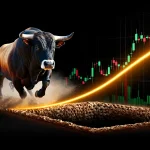? Foolish Behavior: A Guaranteed Path to Market Losses ?
Introduction
In the stock market’s cold, relentless arena, one truth is as brutal as it is inevitable: foolish behaviour is a fast track to financial ruin. If you keep repeating the same reckless moves—buying high out of greed, selling low in panic, and chasing trends like a rabid dog—you’re not just playing with fire but lighting yourself up for an inferno. This isn’t a gentle critique or well-meaning advice—it’s a hardcore wake-up call. This essay lays it all out, filled with raw facts, undeniable data, and real-world examples. We’ll show you how mindless, herd-driven decisions cost fortunes while an astute, nimble approach can flip the script. No fluff. Just brutal truth.
The Anatomy of Foolish Behavior
Foolish investing behaviour is not just a series of bad decisions—it’s a pattern, a self-sabotaging cycle that, when repeated, ensures ruin. At its core, this behaviour is fueled by emotional impulses: greed, fear, and a pure, unadulterated herd mentality. Investors caught in this cycle act like automatons, repeating the same mistakes repeatedly with the irrational expectation that the outcome will somehow change. It’s like stepping onto a treadmill expecting to go somewhere different.
Consider the mindset of those who panic sell at the slightest hint of trouble. They get gripped by the fear of missing out on a recovery or, conversely, by the terror of mounting losses. This emotional hijacking leads to rash decisions—selling too soon, holding too long, or chasing unattainable highs. In every instance, the common denominator is the refusal to adapt one’s strategy. Instead of reassessing and evolving, these investors stubbornly repeat historically proven disastrous decisions.
Foolish behavior is not born in a vacuum—it is endemic. Looking at the behavioural patterns during market disruptions tells a stark story: when fear grips the masses, rationality is thrown out the window, and collective stupidity takes over, dragging the market (and your portfolio) down.
Historical Cases of Financial Destruction
The annals of financial history are riddled with examples of how collective foolishness leads to devastating market crashes. The dot-com bubble of the late 1990s is a textbook case. Intoxicated by the internet revolution’s promise, investors threw money at tech stocks with no regard for fundamentals. Everyone was chasing the same mythical future without considering the reality behind earnings or viable business models. When the bubble burst, billions evaporated almost overnight, leaving a trail of ruined fortunes and shattered dreams in its wake.
Fast-forward to the financial crisis of 2008—another stark lesson in the cost of collective stupidity. Amid widespread panic, investors abandoned solid assets out of sheer desperation. In an irrational sell-off, prices plummeted to levels that were divorced from the underlying value of companies. Those who had the foresight to cling to a disciplined, strategic approach eventually profited from the subsequent recovery, while the majority, driven by fear and herd mentality, suffered irreparable losses.
Even the chaos of the recent COVID-19 market crash demonstrated how quickly collective foolishness can bring order to a maddening descent into ruin. As governments and economies faltered, millions of investors sold off their positions in a frenzy of panic. Technical indicators flashed warnings of oversold conditions, yet too many chose to follow the frenzied crowd rather than act contrarily. The result? Massive, avoidable financial destruction that could have been mitigated with a cool head and a disciplined strategy.
Actionable Data: The Numbers That Don’t Lie
Let’s cut the rhetoric and look at the hard data. Studies have consistently shown that investors who repeatedly commit to the same unthinking emotional strategies underperform by staggering margins. A 2019 Journal of Behavioral Finance study demonstrated that those who sold during a market downturn locked in losses that were, on average, 30% worse than those who stayed the course with a long-term plan. Moreover, data from the 2008 crisis shows that panic-driven selling led to trading volumes up to three times the norm, which only deepened the market’s collapse.
Another study focusing on investor behaviour in volatile markets revealed that approximately 75% of retail investors tend to sell in panic during market crashes, often at the worst possible time. This herd behaviour strips opportunity for buying at a discount and ensures that those who remain are left with disproportionately smaller portions of recovery gains. The numbers are unforgiving: repeated cycle after cycle of the same foolish behaviour guarantees that your portfolio will haemorrhage value over time.
It’s a hard truth that underscores the need for a radical change in approach. The data is clear—emotional trading, blind following of the herd, and an unwavering commitment to outdated strategies lead to financial ruin.
The Path to Winning: Change Your Perspective
You must shift your perspective drastically to avoid the fate that awaits those who wallow in collective stupidity. The first step is understanding that the market’s insanity is not meant to be mimicked—it’s a cautionary tale. Instead of being seduced by the frenetic buzz of each market downturn or rally, you must take a step back and look at the bigger picture.
Smart investors know that when the masses act irrationally, that is your cue to be contrarian. If the market is in the clutches of panic-induced selling, that’s the prime moment to buy. Conversely, it’s time to take profits when euphoric optimism pushes valuations to unsustainable levels. Changing your perspective means recognizing that every market move is not a signal to follow but an opportunity to act independently based on discipline and data.
Imagine this: While the herd is busy dumping their assets in a frenzy, you stand there, analyzing charts, questioning market sentiment, and using every tool at your disposal to determine if that frantic selling is based on facts or mere panic. This pivot in mindset isn’t just theory—it’s a proven approach that has turned dire situations into golden opportunities for those with the courage to think differently.
The Market Trifecta: Common Sense, Mass Psychology, and Technical Analysis
Success in the stock market demands more than intuition or expert advice—it requires a strategic blend of common sense, mass psychology, and technical analysis.
Common Sense keeps you grounded, cutting through hype to assess real asset value. It helps identify unjustified price swings and recognize when emotion, not fundamentals, drives the market.
Mass Psychology reveals how collective fear and greed create opportunities. By tracking sentiment indicators like the VIX and trading volumes, you can anticipate overreactions and position yourself accordingly.
Technical Analysis adds precision, using charts, moving averages, and indicators like RSI to confirm when prices are overextended. This data-driven approach eliminates guesswork, strengthening your market edge.
Together, these three elements form a powerful strategy—helping you navigate irrational market trends and turn volatility into opportunity.
Lessons from the Trenches: Data Over Emotion
Market history proves one thing: following the herd leads to disaster. Independent, data-driven investors consistently outperform emotional traders.
Warren Buffett vs. the Dot-Com Bubble (1999-2002)
While tech speculators chased overvalued internet stocks, Buffett stuck to fundamentals, avoiding companies with no earnings. When the NASDAQ collapsed 78%, wiping out billions, Buffett’s Berkshire Hathaway thrived—proving that hype is no substitute for value.
The COVID-19 Crash and Rebound (2020)
In March 2020, the S&P 500 plunged 34% as fear-driven investors liquidated holdings. Contrarians spotted RSI and VIX extremes, signalling oversold conditions. Those who bought blue-chip stocks like AAPL, MSFT, and AMZN at their lows saw 100%-200% gains within 18 months.
Michael Burry vs. the 2008 Housing Crisis
While banks and investors ignored reality, Burry used data to short the subprime mortgage market. His bets netted $700 million, while the S&P 500 dropped over 50%. His success underscores that understanding fundamentals beats blind optimism.
The takeaway? Facts over fear. Discipline over speculation. The market punishes irrationality—but rewards those who think ahead.
Avoiding the Trap: Becoming an Enlightened Investor
Success in the markets requires discipline, data-driven decision-making, and the ability to counter emotional biases. Here’s how to refine your approach:
Recognize the Warning Signs
- Market panic is often exaggerated. During the 2008 financial crisis, the S&P 500 plunged nearly 40%, but those who bought at the bottom in early 2009 saw gains exceeding 400% over the next decade.
- Sentiment indicators expose extremes. The VIX (Volatility Index) typically spikes during downturns—levels above 30 suggest heightened fear, while levels below 15 indicate complacency.
Stick to a Disciplined Strategy
- Predefine entry and exit points. For instance, traders using a trailing stop-loss of 10-15% on high-growth stocks often mitigate losses while securing gains.
- Avoid reactive trading. Research shows retail investors who panic-sell often re-enter the market too late, missing out on recovery rallies.
Educate and Evolve
- Review your performance. A 2016 study by Barber & Odean found that investors who frequently reviewed and adjusted their strategies outperformed those who did not.
- Learn from history. The dot-com crash of 2000 wiped out speculative stocks, yet investors who focused on real earnings (like Amazon) turned $1,000 into over $100,000 within two decades.
Embrace Counter-Cyclical Thinking
- Buy when others panic. Warren Buffett’s famous principle: “Be fearful when others are greedy, and greedy when others are fearful,” is backed by data—the best returns often come from buying in bear markets.
- Confirm sentiment shifts with technicals. If RSI drops below 30, signalling an oversold market, historical data suggests a 70% probability of a short-term rebound.
Practical Strategies and Tactical Adjustments
A well-structured investment plan combines data, discipline, and adaptability to maximize returns.
Set Clear Goals
- Define short-term vs. long-term strategies: Day traders rely on minute-to-hour charts, while long-term investors focus on multi-year trends.
- Risk tolerance dictates allocation—historically, a 60/40 stock-bond portfolio has balanced risk and return over decades.
Leverage Data-Driven Tools
- RSI below 30 often signals an oversold stock, while above 70 suggests overbought conditions.
- Bollinger Bands help identify breakouts—when prices consistently touch the lower band, a reversal may be near.
Diversify Your Approach
- Sector allocation matters: In the 2020 crash, tech stocks fell sharply but rebounded 50%+ in months, while energy lagged.
- Geographic diversification reduces risk—U.S. markets dominate, but emerging markets often outperform during global expansions.
Stay Nimble
- Adapting to new trends is critical. Investors who ignored shifting market dynamics missed the rise of sectors like AI, EVs, and biotech.
- Algorithmic trading now accounts for over 60% of U.S. equity trades—understanding technicals is more crucial than ever.
Implement a Fail-Safe
- Trailing stop-loss orders prevent catastrophic losses—many traders set them at 8-15%, adjusting based on volatility.
- Position sizing is key. To protect against major drawdowns, no single trade should exceed 5% of total capital.
These principles are not theoretical—they are backed by decades of market data and proven strategies that separate smart investors from those who fall victim to emotion-driven decisions.
Crush Collective Stupidity—Dominate the Market
The data is clear: following the herd is financial suicide. Time and again, irrational investors chase bubbles, panic in downturns, and ignore proven signals—only to be wiped out. History doesn’t lie: the dot-com crash, the 2008 meltdown, and the 2020 panic all proved that emotional trading destroys portfolios.
But here’s the truth: you don’t have to be part of the wreckage. The elite investors—Buffett, Burry, Druckenmiller—win because they reject herd mentality and execute disciplined, data-backed strategies. They capitalize on oversold panic, euphoric overextensions, and irrational sentiment swings while the masses self-destruct.
Your edge? A strategy sharper than any trend-chasing gambler’s gut feeling. Master common sense, mass psychology, and technical precision.
- When fear spikes (VIX above 30), smart investors prepare to buy.
- The wise take profits when the RSI signals extreme euphoria (>70).
- When the media screams doom, another opportunity is near.
Market success isn’t luck—it’s a ruthless game of discipline and adaptability. Break free from the cycle of failure, wield data like a weapon, and seize the opportunities that fools ignore.
Act boldly. Trade with precision. Dominate the market.











